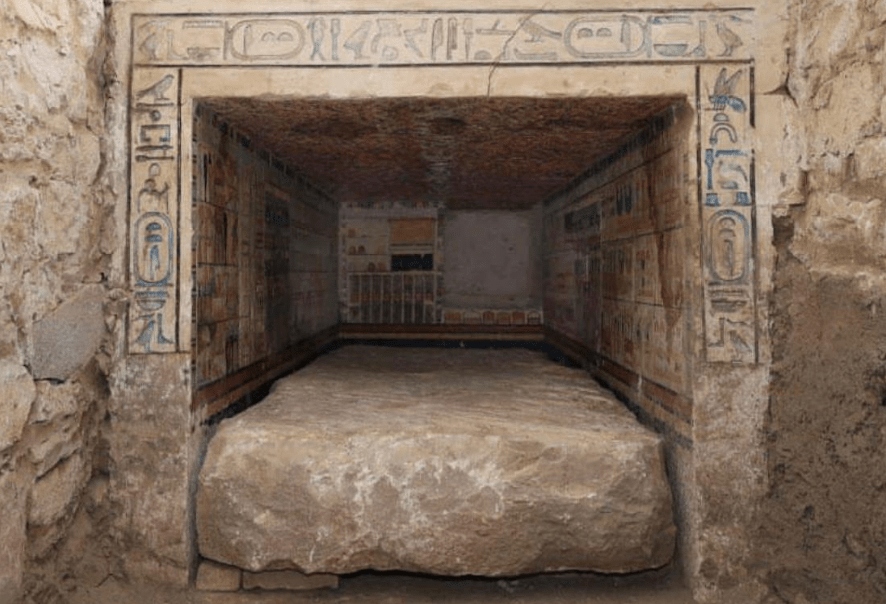By Malak Khaled
Two fascinating archaeological discoveries have recently come to light at Saqqara, one of Egypt’s most renowned historical sites.
A joint Egyptian-Japanese mission uncovered four tombs from the late Second and early Third Dynasties, along with over ten burials from the 18th Dynasty of the New Kingdom.
Meanwhile, a French-Swiss team discovered the tomb of an Old Kingdom royal physician, providing new insights into ancient Egyptian life. Together, these findings highlight the ongoing importance of Saqqara in uncovering the secrets of Egypt’s past.
4 Tombs and 10+ Burials Uncovered: Egyptian-Japanese Discovery
The joint Egyptian-Japanese archaeological mission has made an exciting discovery, revealing four tombs dating back to the late Second and early Third Dynasties, as well as more than ten burials from the 18th Dynasty.
This find extends the known boundaries of Saqqara, proving that the necropolis is even larger than previously thought. The discovery of burials from the early Eighteenth Dynasty also confirms that Saqqara began serving as a cemetery for the restored city of Memphis after the Hyksos were expelled.
Among the tombs uncovered are two mud-brick mastabas and two rock-cut tombs. One mastaba, located near the northern edge of the plateau, has an upper structure and a burial shaft sealed with limestone, leading to the burial chamber below.
The other one, situated near the rocky slope, consists of a mudbrick structure with a rectangular pit at its center.
The team also unearthed several valuable artifacts, including pottery, mummified human remains, a limestone block, and pieces of wooden coffins, all of which shed light on burial customs and daily life in ancient Egypt.
The Tomb of Teti Neb Fu: French-Swiss Discovery
In another discovery, a French-Swiss archaeological mission uncovered the tomb of “Teti Neb Fu,” a royal physician who lived during the reign of King Pepi II in the Old Kingdom.
This beautifully adorned mastaba offers a rare peek into the life of an elite professional in ancient Egypt. The tomb features a painted false door and vibrant scenes of funerary offerings.
Teti Neb Fu held a number of important titles, including Chief Palace Physician, Priest and “Magician” of the Goddess Serket, Chief Dentist, and Director of Medicinal Plants—highlighting his diverse expertise in both medicine and spiritual practices.
Despite signs of ancient looting, much of the tomb’s artwork and inscriptions remain intact, offering valuable insights into the cultural and social practices of the time.
The walls depict scenes of funeral rituals, offering lists, and depictions of various funerary goods. The tomb’s ceiling, painted to resemble granite stones, further adds to the tomb’s visual splendor.
The mission also discovered a stone sarcophagus with hieroglyphic inscriptions bearing Teti Neb Fu’s name and titles, shedding light on his important role in ancient Egyptian society.
Saqqara’s Enduring Importance
Saqqara remains one of the most significant archaeological sites in Egypt, providing a unique glimpse into the lives of ancient Egyptians. The necropolis has long been the burial site of Egyptian elites and kings, including the famous Step Pyramid of Djoser, the world’s oldest stone structure.
These recent findings from the Egyptian-Japanese and French-Swiss missions enrich our understanding of Saqqara’s history and its role as a center of cultural and religious life.
As new secrets are revealed, Saqqara continues to captivate researchers and tourists alike, offering a rare and invaluable window into the grandeur of ancient Egypt.
WE SAID THIS: Don’t Miss… Zahi Hawass Unveils the Secrets Of Saqqara In ‘Unknown: The Lost Pyramid’ On Netflix



